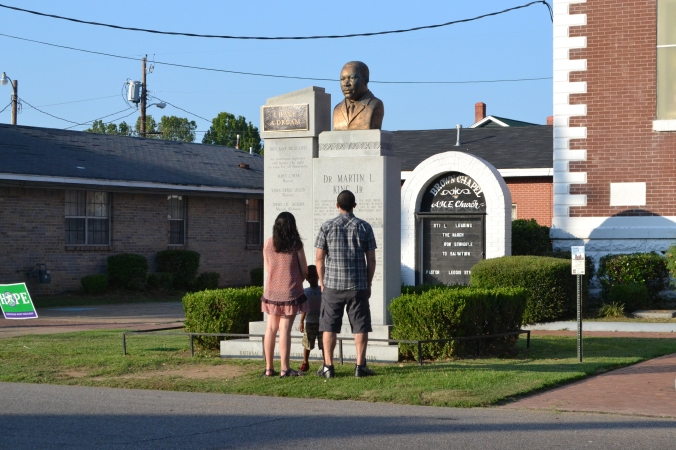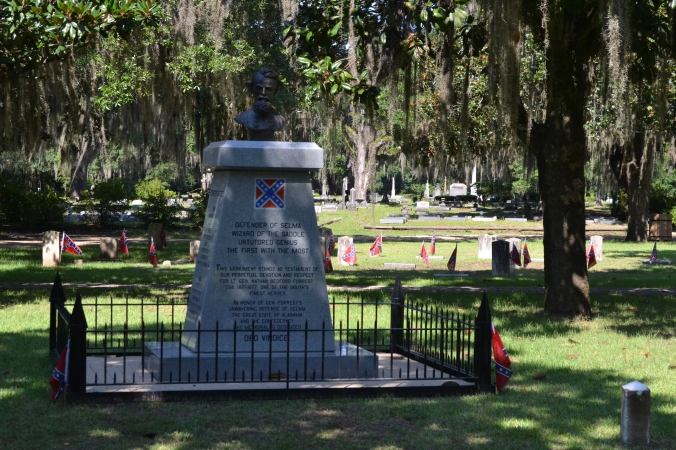
Brown Chapel AME Church in Selma, AL, central to the movement for Voting Rights
During my senior year of college I wrote my honors thesis about my family’s history in the Lodz Ghetto in Poland during the Holocaust. A year later, during a mostly solo seven-month journey through Europe and Israel, I traveled to Lodz, and went on to Warsaw, Krakow and the Auschwitz-Birkenau concentration and death camps. It was 1994 and I was 23 years old, and I traveled this piece of my trip with my best friend. I wouldn’t meet my husband for another five years, but I remember feeling unexpectedly victorious as I walked the tracks into Birkenau, toward the crumbling brick remains of the crematoria, dreaming of the Jewish man I would one day marry and raise Jewish children with. Another generation. I thought about how happy that would make my grandmother, a survivor of Auschwitz and Theresienstadt concentration camps, who had died when I was 13. (I know she smiled the day my husband was ordained as a rabbi.)
Walking on those tracks that the Jews in cattle cars had ridden toward their imminent deaths felt like the most powerful vindication to the evil forces and hateful humans who had tried to exterminate my family and my people. I found myself laughing because they had failed, because I was alive, two generations later, and my line would continue. I married a man whose family were also survivors, who came from a town just 30 kilometers from Lodz, where my family had lived for generations before the war. I like to think we might have met in a different way, in a different place, regardless of Hitler. Besheret. Meant to be.
Those two experiences – unraveling the untold stories of my family as I researched my thesis, learning about those who were killed by the Nazis and those who survived, and returning to the places where they had lived and where so many had died – were cathartic and healing. They were also infuriating and disheartening, because I knew I could never recover so much of what had been lost, and because I saw the way the Holocaust had inflicted a sharp and jagged crack in my family, one that has become a profound part of its legacy. One that still impacts who we are.
What I didn’t know that day walking down the tracks of Birkenau at age 23 was that I would, almost 20 years later, adopt a black son. And that the sharp and jagged crack of my family story would intersect with the sharp and jagged crack of his own history – one he is still, at age four, too young to comprehend.

Named for a Confederate general, the Edmund Pettus Bridge was the beginning of the march for Voting Rights from Selma to Montgomery, AL, in 1965, and also the site of Bloody Sunday, when nonviolent protestors were violently assaulted by police.
We just returned from a family trip to Alabama to visit the Civil Rights Trail between Birmingham, Selma and Montgomery. We’ve been living in the South, in Atlanta, for four years, touching Civil Rights and the country’s dark history of racial injustice against black people a little more closely than we did during our years growing up in California. But I wanted to know more, to touch more, to face more, to understand more about my son’s story – about my country’s story. So we set off with intention for all four of us – not just our black son, who is just starting to see the difference in the color of our skins, but our biological teenage daughter and ourselves, their white parents.

The Foot Soldier statue at Kelly Ingram Park in Birmingham, AL. There is a fascinating podcast about the statue at http://www.revisionisthistory.com.
I am filled with images from our journey, of the Civil Rights sites we visited and the stories we heard about the Voting Rights March between Selma and Montgomery in 1965. Of the juxtaposition of Civil Rights and Civil War that is ever present in the South – Confederate flags honoring the fallen soldiers buried in the cemetery in Selma, monuments to Confederate heroes celebrated for their valor in the struggle for “states’ rights,” (or the right to own other humans). Heroes who went on to don white hooded robes and lynch those who had recently been “freed.”

Monument to Nathan Bedford Forrest, Civil War hero and grand wizard of the Ku Klux Klan, Old Live Oak Cemetery, Selma, AL
But this is the image that remains with me: We are in Cahawba, the ghost town that remains of what was the original capital of Alabama in the 1800s. A few fallen down houses remain, surrounded by barbed wire, one inhabited by the descendant of slaves as late as 1995. The slave quarters of a now-erased grand mansion remain, spookily boarded up but recently whitewashed with fresh paint.

Slave Quarters, Old Cahawba Ghost Town
We make our way through a field to what was the slave cemetery, and follow the guide on a piece of paper to the ten graves that are marked with numbers. We read that these ten are only the graves whose occupants are known, but that the cemetery has hundreds of other unmarked graves where people whose skin is brown like my son’s rest. You know you are passing one because the earth there is more sunken than its surrounding soil. It’s hot and damp because it is July in the South, and it is incredibly quiet. We are the only ones there.


Old Cahawba Slave Cemetery
My son runs ahead looking for the next marker, proud to show us he knows his numbers. My black son whose ancestors were abducted from their people and their homes and came to America on slave ships. My black son whose ancestors were sold at auction, enslaved. My black son whose ancestors labored their entire lives and were beaten mercilessly and separated from those they loved. My black son whose ancestors were raped by their white masters. My black son whose ancestors escaped bondage for freedom in the North, and who were recaptured by slave hunters. My black son whose ancestors labored as sharecroppers after they were told they were free. My black son whose ancestors were lynched on the town square surrounded by an audience of white spectators. My black son whose ancestors learned that separate was not equal, and that to stay alive it was best to look down when a white person walked by. My black son whose ancestors fought Jim Crow and marched for justice. My black son whose ancestors followed the Great Migration north into Ohio, seeking a better life, finding a different kind of discrimination and segregation in urban ghettos.

Soil collected from the sites of over 4,000 documented lynchings of black people in America, a project of the Equal Justice Initiative, http://www.eji.org
My black son whose history I don’t know and can only imagine; who only knows (for now) that Dr. Martin Luther King, Jr. and his sisters and brothers marched for justice because there was a time when things weren’t fair. My black son who grasped for the first time while we were in Alabama that black people – his people – were once slaves like the Jews in Egypt. This is his entry into understanding slavery, because for three years in Jewish preschool he has learned the story of Moses and Pharaoh at Passover.
He runs to the next marker and I walk toward him, wondering about those who came before him. In the same way I did about my own ancestors as I walked into Birkenau. My story and his story – our cracked histories intersecting – different stories with a shared experience of violation, of murder, of genocide, of a history and people exterminated. But our stories are different in one critical way: The violation against his people didn’t stop when slavery ended. It didn’t stop when Jim Crow was outlawed. It didn’t stop with the Voting Rights Act. (Especially as that is being unraveled today.) It didn’t stop when schools were desegregated. (Especially as schools resegregate today.) It didn’t stop when a man with the same color skin as his became President of the United States of America. The violation against his people keeps taking different forms, and racial discrimination is alive and well. That cracks my already cracked heart into a million pieces. Because these are the stories of his heritage and the reality of his present that I have a responsibility to explain to him as he grows older.
And I’m not sure how to tell those stories in a way that instills hope.

Civil Rights Memorial Park, Selma, AL
I am the white Jewish mother of a black Jewish son. My ancestral story, my ancestors, will become his only if he chooses them. But even if he does, he has another critical story. His own ancestral story is a different one than mine. His roots originate in a different part of the world, and his path winds through other places in ways I don’t think I can ever claim to completely understand.
I want to give my son heroes; for now he has Dr. Martin Luther King, Jr. and Mrs. Rosa Parks. I want to give him ancestors, but I know so little about his roots that I can only put pieces together from a broader, painful story. I want to give him community, a sense of belonging to his own people – both black and Jewish.
I want to give him his own story, but I know it will be his to write, his to tell, and his to claim.

Civil War Memorial, Montgomery, AL

